

SmartGeometry is a not-for-profit, educational organization founded in 2001 and directed by three London based architects and friends: Lars Hesselgren of Kohn Pederson Fox, Hugh Whitehead of Foster + Partners, and J Parrish of Arup Sport. These pioneering practitioners are responsible for designing, describing and building some of the most innovative and experimental buildings of our generation. These include KPF’s designs for the new Bishopsgate Tower in London, Foster + Partners’s iconic Swiss Re and new Beijing Airport, and Arup Sport’s collaboration with Herzog & de Meuron on Munich’s Allianz Arena and the new ‘birds nest’ National Stadium in Beijing.
By Terri Peters
The 6th annual SmartGeometry workshop and conference was held in March 2009 in San Francisco with Bentley Systems, (makers of MicroStation and new parametric software GenerativeComponents) as the principal sponsor. GenerativeComponents (known as GC), is a software originally created by architect Robert Aish, a founding member of SmartGeometry who is now at Autodesk. Unlike Catia for automotive or aerospace engineering or Maya for the animation industry, GC is a parametric software that has been designed for architecture. GC is a flexible design environment that can be linked to other software and is designed to be used both as a digital sketching tool for early design development and as a production tool.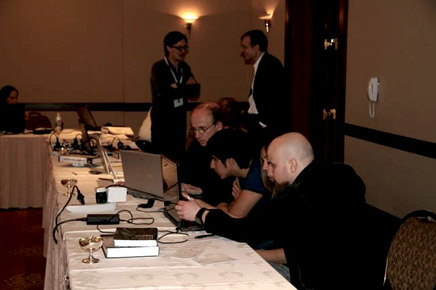
↑ Click image to enlarge
Students working
The Workshops
The ‘students’ who were selected for a place at the four-day SmartGeometry workshops are researchers, students and tutors from schools of architecture in North America, Europe and Australia as well as practitioners from various International architecture and engineering practices. Some attended a 2 day crash course in GC preceding the conference to familiarize themselves with the software, although many had learned it on their own or through the SmartGeometry community, which holds trainings sessions at various universities.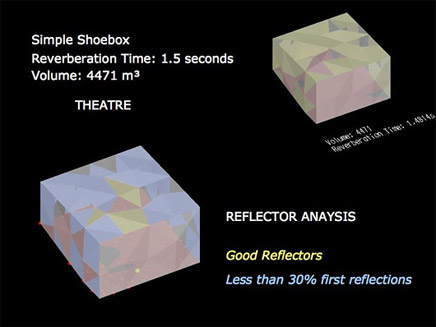
↑ Click image to enlarge
Kirsten Verboven and Tim de Pessemier, Master of Architecture students, University of Ghent, Belgium: Verboven and de Pessemier collaborated during the workshops on this project about parametric acoustics. (Click on this and all of the images to get a detailed view)
Each student came to the conference with an architectural design project to work on during the course of the four days. The scale and scope of works ranged widely, from designs for parametric acoustics as seen in the works of Kirsten Verboven and Tim de Pessemier at University of Ghent, to a project concerned with digital craftsmanship by Martin Tamke at CITA in Copenhagen. Erica Swesey Savig from University of Pennsylvania investigated biology and the potentials of life-like interfaces for architecture. A highlight was the work by Flora Salim at RMIT in Melbourne which was a project that hooked up Wii-motes to parametric software enabling 3D drawing and other interactive experiments.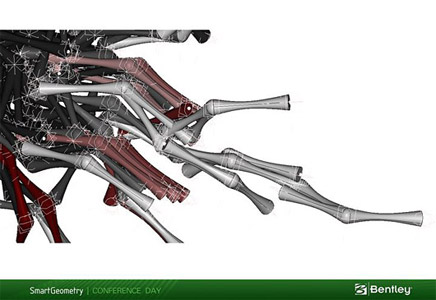
↑ Click image to enlarge
Martin Tamke, Architect and Adjunct Professor, Centre for Information Technology and Architecture (CITA), Royal Academy of Fine Arts, School of Architecture, Copenhagen, Denmark: Solving weaving patterns: merging design and fabrication as exemplified in Zollinger Wood constructions.
Cincinnati based student Devin Jernigan’s ‘Regenerating Tower’ project uses data from the US Environmental Protection Agency identifying dirty waste points in NYC. The points themselves are proposed as sensors for the city, which determine highest density regions where cleansing “seed” towers could formulate to store, clean, and redistribute the waste material, acting as a local ecological contact with the city.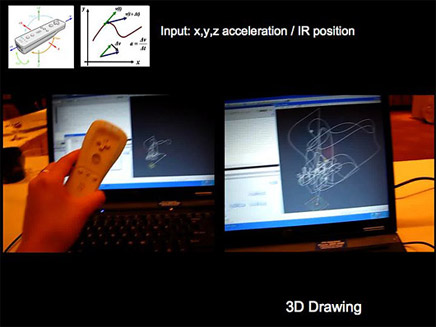
↑ Click image to enlarge
Flora Dilys Salim, Spatial Information Architecture Laboratory (SIAL) at Royal Melbourne Institute of Technology (RMIT): Beyond 3D- Digital form finding and exploration with a wii-mote.
The work of Kevin Van Hauwaert from University of Ghent was concerned with mass customization and new rapid manufacturing technologies. Van Hauwaert created computer scripts using GenerativeComponents to control a building-sized 3D printer, part of his ongoing collaboration with Loughborough University.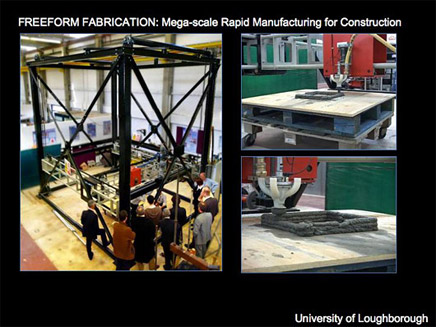
↑ Click image to enlarge
Kevin Van Kauwaert, Master of Science, Architecture student, University of Ghent, Belgium: Freeform fabrication: Mega-scale rapid manufacturing for construction.
Aiming for innovation rather than incrementally improving the efficiency of their designs, the students seemed to delight in making software do what they wanted it to do, not for what it was intended. The students created their own custom tools (GC is a good tool-making device) and created interfaces with other software as required, rather than being guided by what could be done easily in one platform.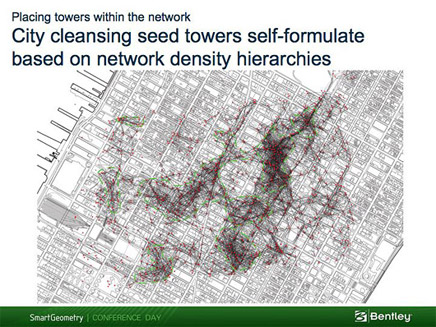
↑ Click image to enlarge
Devin Jernigan, University of Cincinnati, USA: Regenerating Tower is an idea for a skyscraper that can be a power plant and cleansing system for the city, collecting energy, air, and water for purification and redistribution.
The students had access during the workshops to a ‘Fablab’ with 3D printers and laser cutters so that they could output their digital ideas to prototypes. The students could test their designs in a 3D print, and then come back a few hours later to make another version, using the technologies as tools for critically testing their ideas.
Alumni Summit and Conference Day
After the workshops, the Alumni Summit gives attendees a unique insiders look into in-progress professional and academic work mainly by the SmartGeometry core members. These young international lecturers and practitioners include Jenny Sabin from University of Pennsylvania, Steve Sanderson from CASE Inc, Axel Killian from TU Delft, and Mirco Becker from KPF.
The final day of SmartGeometry was the Conference day, where the SmartGeometry directors introduced a selection of speakers ranging from Brett Steele from the Architectural Association School in London to David Kasik from Boeing to several presentations about sustainability, notably from Judit Kimpian of Aedas and Jim McBride from Makani Power. Kimpian, together with colleague Josh Mason of Aedas and Jeroen Coenders from Arup presented collaborative research about sustainability with regard to tall buildings. McBride gave a non-architectural perspective about sustainability, with regard to personal energy consumption and accountability featuring experimental research into giant energy generating turbine planes.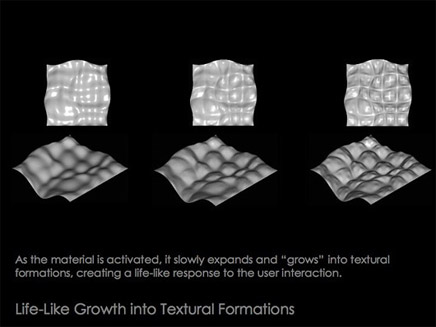
↑ Click image to enlarge
Erica Swesey Savig, University of Pennsylvania, Sabin+Jones Labstudio: Designing the reciprocal relationship between user and environment through life-like interface studies.
But ‘Parametrics’ was the word of the day. The word was used so often that Chris Williams from the University of Bath joked that “Do You Believe in Parametrics?” sounded like an obscure theological question. Williams says he’s not sure if he is a ‘believer’, but he reveals he does believe in design and optimization. Williams’s presentation featured classic cars and an alternative pre-digital history of parametric design including his own collaborations with Frei Otto.
↑ Click image to enlarge
Roham Sheikholeslami, Graduate student, School of Interactive Arts and Technology, Simon Fraser University, Vancouver, Canada: Hysterical Space: How can a parametric modeling system support the recombination of prior decisions into new states that are meaningful to designers?
A highlight of the conference day was architect Mark Burry’s presentation of his work on Gaudi’s unfinished masterpiece Sagrada Familia. Burry has been working on the project for 30 years (!). Burry works with parametric design and modeling, large scale rapid prototype models, laser cut shuttering for concrete, and a shared 3D model which generates the plans for fabrication. He uses a seven-axis robot operated by the Spanish stone mason who has been involved with the project ‘since the beginning’.
Conclusions
What seems apparent from presentations at the Alumni Summit and the Conference Day is that in practice, architects are using many types of digital tools over the course of a single project. The future of CAD seems to be in software links and custom scripts, not in the development of a single, multi-tasking CAD package. A designer could start with Ecotect, add a bit of Rhino VB script, then a little bit of Visual Studio or GenerativeComponents and then output to both Autocad and MicroStation due to the various functionality of both.
In this uncertain economic climate, with (all?) high profile architectural projects ‘on hold’, there is little doubt that understanding at least the potentials –if not the specifics—of parametric design is a useful design skill. The annual SmartGeometry conference is particularly relevant because it is about research and practice, combing theory and practical experience. Students of architecture graduating now know they need to have quality examples of their digital skills in order have a competitive CV. This is changing the way schools teach design and technology. In the last five years many schools of architecture have extended their workshop facilities to include laser cutters and 3D printers and there seems to be an expensive game of one-upmanship with ever increasing complexity in multi-axis robot milling machines. The two new robots at Harvard’s GSD may be 6 axis robots, but the TU Vienna has a 7 axis machine, and ETH Zurich has an 8 axis robot.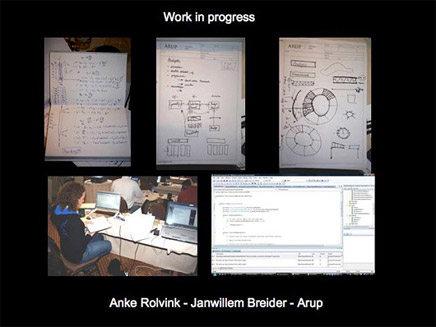
↑ Click image to enlarge
Anke Rolvink, Graduate structural engineering student at TU Delft and Arup and Jan Willem Breider, structural engineer at Arup Amsterdam: Breider and Rolvink collaborated during the workshops on this project about creating a parametric structural design system that could be applied to high rise, large span structures.
But when do architecture students find the time and expertise to learn how to program robots? Increasingly it is not unusual for students to ‘pick up’ computer programming and environmental analysis software like Ecotect in their first few years of study. And those in practice know that rapid prototyping is becoming commonplace in many design offices, although many send out the work rather than have facilities in house. A parametric 3D model can be used to test multiple options efficiently to make sure clients are getting value for money in terms of design and building performance and it can be a way of controlling accuracy.
SmartGeometry is a unique educational resource (crucially well funded by industry) that is succeeding in creating a network of forward looking architects interested in new technologies, and this may be what keeps the industry competitive in these bleak economic times. Adding design and efficiency options to the architect’s toolkit can be a way of making complex designs buildable. Parametric design may not be for everyone (luckily, as these workshop participants would say, as they faced stiff competition for these coveted workshop spots) or for every project, but it is undeniably changing the way many buildings are being designed and the way new architects are being educated. So, as Chris Williams would say, “Do you believe in parametrics?”
Terri Peters is an architect and design journalist who has just relocated from London to Copenhagen, Denmark.
I'm an Assistant Professor at Ryerson in Toronto. Originally from Canada, after studying at Dalhousie, I spent 8 years in London, UK studying and working as an architect and writer. I then moved to Denmark to study for my PhD in architecture 2008-2014. You can read some of my ...
10 Comments
being a drawingboard geriatric this is a really interesting subject...
more from the smart geometries team please!
my immediate gut response is usually: "just because you can, doesn't necessarily mean you should!"
but I do find it interesting that we spend so much time and energy and brain power to precisely calculate things in order to understand or explain them to ourselves . . . especially when such calculations end up proving a much earlier "intuitive" design right (I'm thinking of the Gaudi example here)
I certainly think parametric design is changing the aesthetics of our built environment - and I think this is a good thing
but it scares me a little that architectural education is taking such a turn toward engineering and even computer science all in the name of remaining competitive
Parametric design is leading us towards focusing on architecture as a process rather than a design exercise. These kind of events are another reminder of how we could be gaining much more by intelligent use of technology in architecture. All that is lacking is more practical, physical examples of possible results so we don't forget how real building is.
As with all technologies, parametric software may be used well, or poorly.
At its worst, parametric design will be used to generate yet more so-called ‘iconic’ architectural forms.
At its best, it will be used in response to the economic & environmental crises by optimizing space, structure, material and cost.
I am more of a drawingboard/card model type of person. But even so, I am curious about the potential of the program and what various professions (artists, architects, craftsmen ...) can do with it. Looking forward to next year's conference.
Interesting article. I like the variety in the work being presented. It is great to see that such events/workshops take place so that knowledge can be shared and developed.
as an audience member for the Conference, i agree that one trend was about design as a process of coordinating data from many different software packages. the foster's airport project showed this clearly as a now well-practiced method. i think that brings up one downfall of this SmartGeometry conference, though. it is that it didnt seem too forward-thinking about what are the new up-and-coming ideas, methods, etc. it showed GC and parametric design as an embedded process, but one that has clearly depicted limitations (thus the need to work with other packages outside of it - or script your own devices). one small (maybe new) trend was within the process of working with multiple software packages - people developing custom "lightweight" scripts to solve various structural and/or design-oriented challenges. chris williams, and some work by foster's smg were examples of this.
this report highlights exactly what it is that is so special about smartgeometry - the workshops and the students. sure the conference day is great, with fantastic speakers and everything, but really it is about the students and what they accomplish in the workshops. great work - i think san francisco was the best sg yet!
comment on sa icd
yes - GC is not closed and it does not offer all the tool but a tool writing environment
yes - it can link through c++ librarys, excel etc through other/more specialized packages
and even more - there have been quite a lot of projects in the workshop, where the pure linear thought parametric projects were broken up and new methods of design were tested, which evolve the "well-practiced" method
Its great that such a small community can actually move the profession
revenge of the nerds
Block this user
Are you sure you want to block this user and hide all related comments throughout the site?
Archinect
This is your first comment on Archinect. Your comment will be visible once approved.